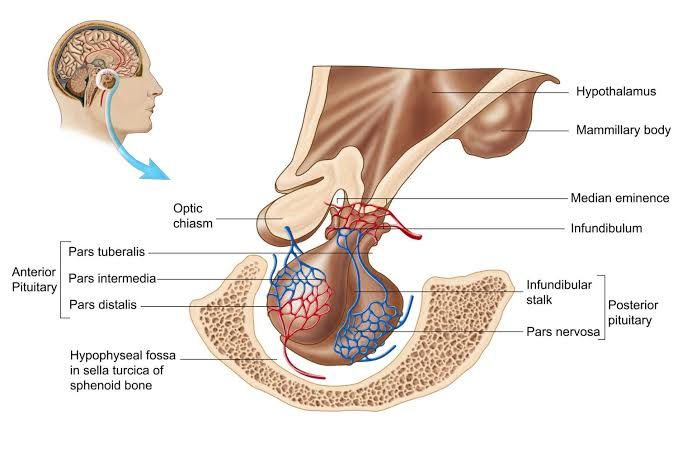
Adenohypophyseal and Neurohypophyseal Hormones
(a) Adenohypophyseal Hormones (Anterior Pituitary)
The anterior pituitary, also known as the adenohypophysis, produces and secretes several hormones that regulate various physiological processes. These hormones include:
- Growth Hormone (GH): Stimulates growth, protein synthesis, and tissue building.
- Thyroid-Stimulating Hormone (TSH): Regulates the secretion of thyroid hormones from the thyroid gland.
- Adrenocorticotropic Hormone (ACTH): Stimulates the adrenal cortex to produce corticosteroids like cortisol.
- Follicle-Stimulating Hormone (FSH): Promotes the production and maturation of gametes (ova in females and sperm in males).
- Luteinizing Hormone (LH): Triggers ovulation in females and stimulates testosterone production in males.
- Prolactin (PRL): Promotes lactation by stimulating milk production in mammary glands.
- Beta-Endorphins: Involved in pain relief and feelings of well-being.
These hormones are regulated by releasing or inhibiting hormones secreted by the hypothalamus.
(b) Neurohypophyseal Hormones (Posterior Pituitary)
The posterior pituitary, or neurohypophysis, does not synthesize its own hormones but stores and releases two key hormones produced by the hypothalamus:
- Oxytocin:
- Stimulates uterine contractions during childbirth.
- Facilitates milk ejection during breastfeeding.
- Plays a role in social bonding and attachment behaviors.
- Antidiuretic Hormone (ADH)/Vasopressin:
- Regulates water balance by increasing water reabsorption in kidney tubules.
- At high concentrations, it causes vasoconstriction to increase blood pressure.
Regulation of Anterior Pituitary Hormones by the Hypothalamus
The hypothalamus regulates anterior pituitary hormone secretion through a specialized vascular system called the hypophyseal portal system. This system allows hypothalamic releasing and inhibiting hormones to directly reach the anterior pituitary without entering systemic circulation.
Mechanism of Regulation:
- The hypothalamus synthesizes specific releasing or inhibiting hormones based on feedback from peripheral endocrine glands or other physiological signals.
- These regulatory hormones are secreted into the primary capillary plexus located at the median eminence of the hypothalamus.
- The regulatory hormones travel through hypophyseal portal veins to reach a secondary capillary plexus within the anterior pituitary.
- Once there, these hypothalamic hormones stimulate or inhibit specific cells in the anterior pituitary to release their respective tropic or non-tropic hormones into systemic circulation.
Examples of Hypothalamic Regulation:
- Corticotropin-Releasing Hormone (CRH): Stimulates ACTH secretion from corticotrophs in response to stress or circadian rhythms.
- Thyrotropin-Releasing Hormone (TRH): Stimulates TSH secretion for thyroid hormone regulation via negative feedback loops involving circulating thyroid hormone levels.
- Gonadotropin-Releasing Hormone (GnRH): Controls FSH and LH secretion for reproductive function; inhibited when sex steroid levels rise significantly.
- Growth Hormone-Releasing Hormone (GHRH): Promotes GH secretion; counteracted by somatostatin, which inhibits GH release.
- Dopamine: Inhibits prolactin secretion under normal conditions; prolactin-releasing factors become active during pregnancy/lactation.
Posterior Pituitary Gland Relationship with the Hypothalamus
The posterior pituitary is anatomically and functionally connected to the hypothalamus via a bundle of axons known as the hypothalamohypophyseal tract.
Key Features of this Relationship:
- The posterior pituitary does not synthesize its own hormones but serves as a storage site for oxytocin and ADH produced by neurons in two specific nuclei of the hypothalamus:
- The paraventricular nucleus primarily produces oxytocin.
- The supraoptic nucleus primarily produces ADH/vasopressin.
- These neurohormones are synthesized as preprohormones within neuronal cell bodies located in these nuclei of the hypothalamus.
- Once synthesized, they are transported along axons within vesicles bound to carrier proteins called neurophysins via axonal transport mechanisms down to nerve terminals located in the posterior pituitary.
- Upon receiving appropriate neural signals from osmoreceptors or sensory inputs:
- Oxytocin is released into circulation for functions such as uterine contraction or milk ejection reflexes during breastfeeding.
- ADH is released into circulation to regulate water retention based on blood osmolarity detected by osmoreceptors.
- This relationship ensures rapid hormonal responses since these neurohormones are stored close to their release sites near blood vessels within posterior pituitary tissue.







